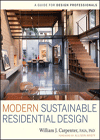Location: Djilor Didjack, Senegal
Project size: 2,800 square feet
Program: Located in the small village of Djilor-Djidiack in the Sine Saloum region of Senegal, the house stands on a sandy beach on the banks of a bolong, a river arm forming an estuary, and is a stone’s throw from the childhood home of the poet Léopold Sédar Senghor, who was once president of Senegal.
The program borrows from tropical houses in Africa as well as the veranda-style residences of the Southern United States, where the structure is surrounded by a belt of shade to limit the effects of the vertical sun.
Design Solution: The design uses natural materials whenever possible, with a foundation made of stone, walls of rammed earth, a framework of wood, and a roof of straw. Thin cement-earth bricks—just under 3 inches thick to limit the use of cement—cover the vaults of four bays, which are arranged in two perpendicular pairs: one bay each for the living area and the kitchen/dining area, and two bays for the bedrooms.
Large windows on the veranda have lateral ventilation openings, and wind from the river flows through the house. The earthen walls retain the cooler evening temperatures, making the house pleasant during the day. While the brick vaults cover the ground floor, the upper floor is covered with a framework made from reclaimed electrical poles that use simple scissor-beam framing, cut with a chainsaw and bolted together. Bamboo poles support the thick straw roofing to protect the large rooms underneath from the sun. On the upper floor, a strip of operable glass windows runs along three of the four facades, offering a panoramic view of the bolong.

Photo © 11h45
Structure and Materials: For the studio, the project marked a return to experimenting with rammed earth, engaging locals from Djilor-Djidiack to help beat the earth into the formwork.
The earthen walls, simple blocks measuring roughly 3-feet-by-3-feet and 14-inches thick, line up in a singular rhythm based on useful and efficient pathways. The window frames brace the building. The massive brick pillars of the porch, triangular in plan, are self-stabilizing, avoiding the need for costly concrete reinforcements. They delimit alcoves that provide places to sit, read, eat, and rest. And, like a monumental bay cut into the thickness of a wall, they frame the growing garden.
The construction is simple, with no sophisticated assemblies. The built elements derive strictly from the application of the constructive rules specific to each material. Thus, the more syncopated rhythm of the massive pillars clashes with the regular beams of the veranda. .
Additional Information
Completion date: April 2024
Site size: 0.22 acres
Total construction cost: Withheld
Client/Owner: Withheld







Photos © 11h45




Images courtesy Gilles Perraudin; click to enlarge
Credits
Architect
Gilles Perraudin Architecte
Chemin des Salines, 30600 Vauvert, France
Associate Architect
Atelier Architecture Perraudin
17 rue Saint Fulbert, 69008 Lyon, France
+33 4 26 02 98 63
atelierperraudin.com
Consultants
Earth construction system: Elementerre
Photographer
11h45
Specifications
Structural Products:
Rammed earth bricks (walls); lime plaster (wall covering); concrete-earth bricks (vaults, made by local artisan); Tiffa (straw roof); reused wood; electrical poles; bamboo
Furnishings:
Furniture design by Gilles Perraudin and made by local artisan





